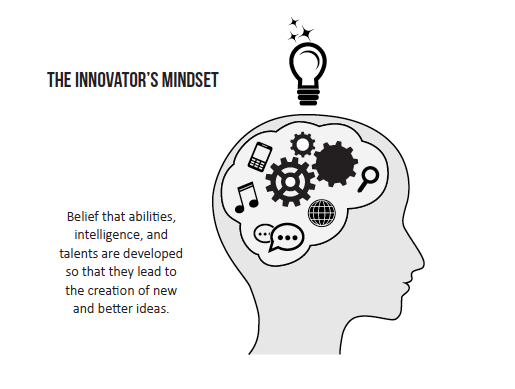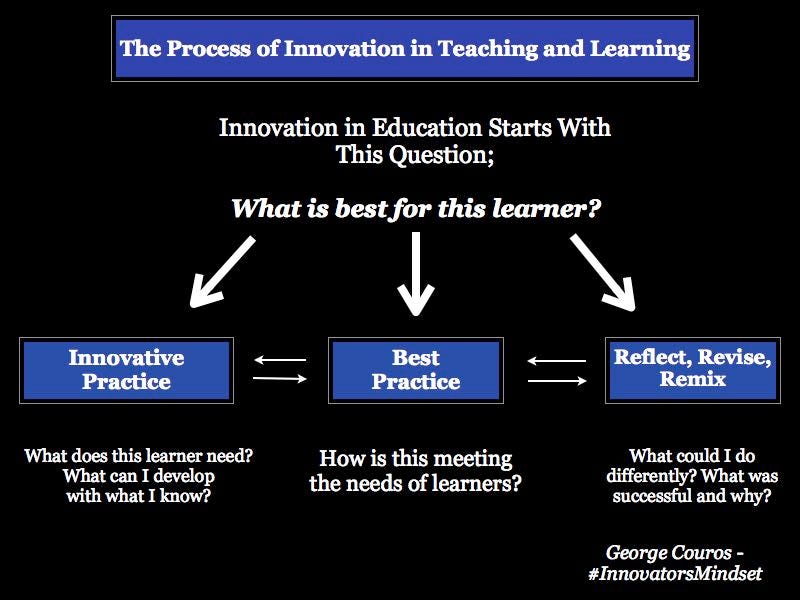by George Couros: https://medium.com/@gcouros/3-misconceptions-about-innovation-in-education-1a57036fce1c
 |
| slideshare.net |
“Innovation” is one of the most used words in education right now. It is something that I am obviously passionate about, hence the reason I wrote the book, “The Innovator’s Mindset”. I am scared that we use the word “innovation” in the wrong way when there is power to this type of thinking. Words do not become “buzzwords” because they are used too frequently; they become “buzzwords” when they are used frequently in an incorrect manner.
Here are some misconceptions about the word that we need to dispell to protect “innovation” in education from becoming a buzzword.
- Innovation is about how you use technology. Nope…this is incorrect. My belief is that this happens because a lot of technologies that are advertised are deemed innovative, which can be true. But innovation is a way of thinking, not simply the way we use technology. For example, is using a “scantron” to mark multiple choice exams innovative? It is definitely convenient, but does this lead to better learning in the classroom? My answer is that it could actually lead to worse learning, faster. Students do not necessarily become better learners, but better test takers. I am not about absolutes, so if you do a multiple choice exam here and there, I am fine with it, but it is not innovative. Using a SmartBoard; innovative or doing the same thing we were doing before, just “cooler”? There are a million ways that you can use google forms, but the ability to use “google forms” is not innovative’; it is what you do with it that creates the innovative practice in the classroom.
- That being said, there are many ways that educators are innovative without using technology. Look at EdCamp. This has become one of the best ways that educators have taken ownership of their own learning yet technology is not necessarily at the forefront of this process; it is the process of the professional learning that is innovative.
- Dispell the myth that “technology equals innovation” and you will see more educators seeing that many things they are doing in classrooms right now are extremely innovative, without or without technology.
- Innovation is about “mindset”, not skill set.
- This leads to the next misconception.
- Innovation is reserved for the few. Again, no. If innovation is about “doing new and better things”, why would this only be reserved for the few? This does not mean you get rid of what you were doing previously, but always evaluating is it working for your students. Many people will stick with things because they know them, not because they are better. This is human nature and happens in relationships all of the time. It is the same for personal as it is for professional.
- The process of innovation in teaching and learning is something that all educators should aspire to. Here is an image that may help you see why it is important.
- Are there only a few educators in your organization that should look at the process of teaching and learning this way, or everyone? This is not something that should be done by the few but should be the norm in school.
- Innovation is solely a “product”. People believe the iPhone was innovative. It is in some ways. Yet it is the thinking that created the iPhone in the first place that was the innovation. Someone had to have a vision of what a “phone” could be, but when you look at the innovation of mobile technology, this has led to other innovations. Uber, AirBnB, iTunes, and a myriad of other developments were created because smartphones were created. Innovation happens in the thinking to create these things in the first place; they did not come to fruition on their own. Many people have great ideas, but making these ideas happen is the innovation. Creativity leads to innovation, but I have met many “creative” thinkers who do not make things happen.
As I have stated numerous times, innovation should not be reserved for the few, but become the norm in education. It trickles into how we do everything, whether that is assessment practices, leadership, professional learning, how we use technology, and so many other areas, but ultimately in teaching and learning. The first step to getting people to move there is to see that this is not an individual effort, but a team sport.
(If you are interested in learning more about “innovation in education”, I would encourage you to read my book, “The Innovator’s Mindset”, if you haven’t already. The hope is that we see innovation become the norm in education, not reserved for the few.)


No comments:
Post a Comment